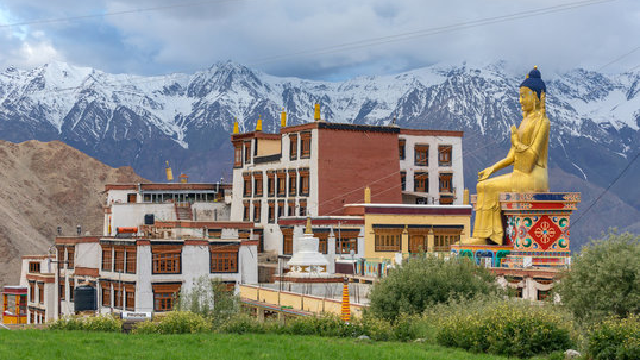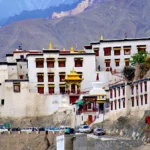Table of Contents
Toggle- Overview
- The History of Likir Monastery: A Journey Through Time
- Likir Monastery Architecture: A Masterpiece of Tibetan Design
- The Religious Importance of Likir Monastery
- Crucial Monastic Rituals and Activities of Likir Monastery
- Festivals at Likir Monastery: A Peek into Tibetan Culture
- The Maitreya Buddha 75 Foot Statue: A Peaceful Symbol
- Likir Monastery Visit Time Preferences
- Trekking and Hiking Around Likir Monastery
- Nearby Attractions: Exploring Ladakh's Cultural and Natural Wonders
- How to Reach Likir Monastery
- What to Expect During Your Visit Likir monastery
- Wrap up: The peaceful nature retreat you have been searching for
- How to book Ladakh tour online?
- People Also Ask
- What is Likir Monastery?
- Where is Likir Monastery located?
- What is the history of Likir Monastery?
- How can I reach Likir Monastery?
- What is the best time to visit Likir Monastery?
- What can I expect to see at Likir Monastery?
- What is the significance of the Maitreya Buddha statue at Likir Monastery?
- What is the Tse-Chu festival at Likir Monastery?
- Are there any trekking opportunities around Likir Monastery?
- Can I stay at Likir Monastery?
- What is the best way to get to Leh from Likir Monastery?
- Can I interact with the monks at Likir Monastery?
- Are there any local attractions near Likir Monastery?
- Is photography allowed at Likir Monastery?
- How long should I spend at Likir Monastery?
- What is the significance of prayer wheels at Likir Monastery?
- Can I participate in meditation at Likir Monastery?
- Is Likir Monastery open to tourists year-round?
- What should I wear when visiting Likir Monastery?
- Are there any local restaurants near Likir Monastery?
- How long does it take to reach Likir Monastery from Leh?
- Can I visit Likir Monastery during the winter?
- What type of activities can I do at Likir Monastery?
- Is there a fee for visiting Likir Monastery?
- Can I learn about Tibetan Buddhism at Likir Monastery?
- Is there a dress code at Likir Monastery?
- What is the importance of Likir Monastery in Ladakh?
- How can I contribute to Likir Monastery?
- Can I buy souvenirs at Likir Monastery?
- What makes Likir Monastery different from other monasteries in Ladakh?
- Inquiry Form
Overview
Likir Monastery is one of the oldest and most important Buddhist monasteries of Ladakh, here is serene environment, majestic views, rich heritage. It offers exceptional peace and is a place of deep meditation which, tranquil, allows for reflection. With vivid beauty, rich heritage, gigantic picturesque mountains, and unmatched calm, Likir Monastery serves spiritual seekers and tourists alike. Likir Monastery also known as Likir Gompa, is located around 52 kilometers off Leh, the capital city of Ladakh.
In this blog, we take an in-depth journey through the history and spirituality behind the monastry, it’s architectural wonders, festivals, surrounding attractions, and give you useful tips should you wish to visit. For people keen on pursuing Tibetan Buddhism, or for people searching for solace, Likir Monastry is an absolute must in rich Ladakh.
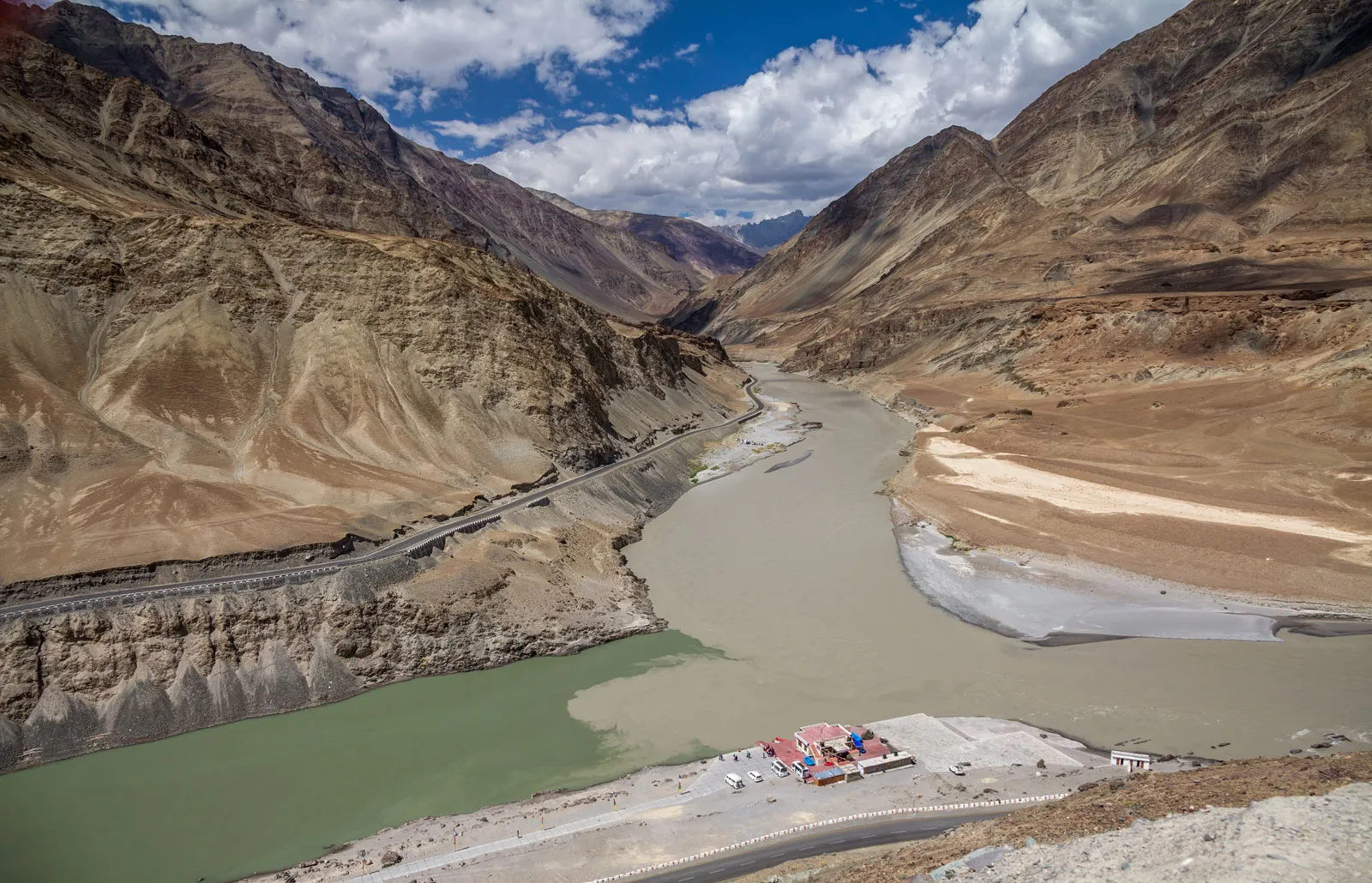
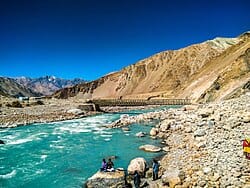

The History of Likir Monastery: A Journey Through Time
The beginning of Likir Monastery links to the 11th century when Tibet as well as Ladakh experienced a spiritual blossoming. This region is known for its ancient historical records, which mention its founding by prominent Tibetan Lama, Duwang Chosje, with support from King Lha-chen of Ladakh. The monastery was built as part of the Gelugpa (Yellow Hat) sect brought to the region by Tsongkhapa, the great Buddhist philosopher and teacher.
Initially, the monastery’s purpose was to serve as central facility for Tibetan Buddhism, Education, as well as Buddhism Practise. Over the centuries, Likir Monastery served to transform the surrounding area into a Buddhist nucleus. The monastery endured numerous invasions and natural catastrophes, but managed to get reconstructed and preserved along the ethnicity fabric and spirituality essence of Ladakh.
Remaining an active religious site, Likir Monastery continues to foster and transmit the knowledge and practices of Buddhism through a community of monks that live within its premises. The site is highly instrumental in helping Ladakh preserve its religious heritage, as the combination of its rich history, culture, and spirituality draws in thousands of tourists every year.
Likir Monastery Architecture: A Masterpiece of Tibetan Design
The architectural design of Likir Monastery reflects Tibetan Buddhist monastery design styles and integrates beautifully with its picturesque surroundings. The monastery is positioned atop a hill which provides it with an unobstructed view of the stunning valleys and villages, all of which are encased in breathtaking mountains.
Main Temple (Dukhang)
Located within Likir Monastery is the main temple, Dukhang, which is also the heart of the monastery. The Dukhang serves as the main sacred hall whereby the monks perform their prayers, meditation, and other rituals. It contains exquisite murals and frescoes of Tibetan Buddhism depicting not only the Life of the Buddha but also many other Buddhist deities and teachings. Dukhang has been meticulously preserved, decorated with frescoes of practitioners, and serves as spiritual guidance, so these murals have greatly retained their artistic value.
Maitreya Buddha, the Buddha of the future, is given special attention as he is located in the center of the temple. The statues and sacred relics allow worshipers to feel the reverence-filled devotion that the monastery holds.
Prayer Wheels and Stupas
Likir Monastery has a number of large prayer wheels that play a significant role in the Tibetan Buddhist ritual. Followers of the faith think that spinning the prayer wheels sends out prayers for the well-being of every living being. The prayer wheels are frequently engraved with mantras and the action of turning them yields to be a form of meditation and spiritual merit.
Along with the prayer wheels, several stupas are also found in Likir Monastery. Stupas are sacred burial mounds that are constructed from relics and offerings. These stupas are representations of the teachings given by the Buddha and are used as focal points for meditation and prayer.
Statue of Maitreya Buddha
Arguably the most astonishing attribute of Likir monastery is the statue of Maitreya Buddha which is 75 feet tall and is located at the entrance of the monastery. The statue, painted with exceptional beauty and delicacy, is made of clay and portrays the Maitreya who is expected to bring enlightenment and peace in the future.
Like a lighthouse in a storm, this gigantic statue serves as hope—it can be seen from far away and represents the grace of a future filled with peace. Most observers are stunned at the peaceful expression on the face of Maitreya which brings a moment of calm and deep thought to its viewers.
The Religious Importance of Likir Monastery
With the blend of culture and religion, Likir monastery is not only an architectural wonder but also holds great importance as a place of worship and spirituality for other sects of Buddhism. It is a part of Gelugpa sect of Tibetan Buddhism which advocates strict adherence to monasticism, zealous meditation, and in-depth intellectual engagement with Buddhism.
The monks at Likir Monastery focus on meditation, rituals, and actually preserving the teachings of Buddha. The monastery their practices have sculpted calmness in the area, which offers opportunities for self-reflection and personal development, is very famous among the tourists and enhances their spiritual encounter with faith.
Apart from the ethetic and initiatives of Likir Monastery, the spiritual teachings incorporates prayers, songs and offering ceremonies. As part of the monk’s daily life, all these rituals can be witnessed. All these rituals, combined, promotes the overall wellness of living beings and supports tranquility in one’s mind.
Crucial Monastic Rituals and Activities of Likir Monastery
While at Likir Monastery,one has the chance to see and take part in almost all the essential exercises of Tibetan Buddhism, these include:
Mantra reciting and prayer sessions: Each day monks are engaged with reciting words and beating drums. Each form of prayer calls for peace and blessings for each and everyone. Every Buddhism devotee needs to take part in mantra reciting or to be a practitioner of chanting as it is considered highly influential for solving brain problems. It is said that this activity gets rid of the man’s spiritual underdevelopment and brings to bloom abundance nurturing, environment.
Tibetan Butter Lamp Offering: Butter lamp offering is one of the very common practices followed in every Tibetan Buddhist monastery. The lamps represent enlightenment and idol veneration since they are believed to bring illumination to one’s life.
Torma Offering: Torma is a kind of symbolic ritual cake made primarily from butter mixed with barley flour and other materials. It is also used as an offering during prayer sessions as a form of tribute that strives to epitomize one of the gifts presented by the material world for the legendary Buddha.
Meditation: The Likir monks spend a huge chunk of their time engaging in meditation. Students of Buddhist teachings may notice some monks deep in meditation – a mental process that purportedly harnesses attention and is intended to enhance empathy and tranquility within oneself.
Festivals at Likir Monastery: A Peek into Tibetan Culture
Among the many significant celebrations taking place in Likir Monastery, the Tse-Chu festival also ranks very high in importance, where the life story and teachings of Guru Padmasambhava, one of the main proponents of Buddhism in Tibet, are celebrated. The festival garners many pilgrims and tourists every year, making it one of the most visited places of worship in the region.
The Tse-Chu festival is celebrated in amd the monastery is full of life by various culture vibrant dance rituals alongside prayer ceremonies. The monks look colorful as they put on their cham dance attire that is known for calming the spirit and shielding one from maleficent forces. A riot of drums, horns and cymbals fills the air while the dances are performed which elevates the already powerful and spiritual atmosphere further.
The Tse-Chu festival offers tourists the chance to experience first hand the culture of the region, their customs and traditions and practices of Tibetan Buddhism. Furthermore, it is regarded as a time when someone is able to reflect for deeply spiritually.
The Maitreya Buddha 75 Foot Statue: A Peaceful Symbol
The Likir monastery is reinforced by the astonishing 75 foot Maitreya buddha statue which is a key attraction for tourism. The virtues of peace, understanding and caring is what this great statue represents.
It is anticipated that Maitreya buddha will succeed the current one and come to this world when shakamuni, the existing buddha’s teachings are rendered obsolete. It stands as a sign of hope for the time to come where the world will be transformed for the better, and calmly situated in the monastery it instills inner peace, calmness and spirituality to the visitors.
When contemplating Maitreya Buddha’s teachings and reflecting on life’s transience, many people prefer to meditate before the statue.
Likir Monastery Visit Time Preferences
The weather in Ladakh is most pleasant from May to September, summer months, so it is the best time for Likir Monastery visits. The temperatures at this time are moderate, with the days reaching 15-25 degrees centigrade (59-77 degrees Fahrenheit), which is great for exploring and trekking.
Traveling to Likir Monastery can be more difficult in the winter due to the severe weather conditions in Ladakh, with temperatures falling to -20 degrees centigrade (-4 degrees Fahrenheit). In addition, a lot of the region’s roads may be closed due to heavy snowfall.
If you wish to attend the vibrant cultural festivities of Ladakh, visiting during the Tse-Chu festival is recommended. This festival occurs in July or August depending on the lunar cycle and is a good chance to see Tibetan Buddhist rituals and cultural shows.
Trekking and Hiking Around Likir Monastery
The Likir Monastery site is extremely beautiful as it is encircled by high rugged mountains and deep valleys. This makes it a perfect site for trekking and hiking enthusiasts. Frequency of trekkers climbing up the monastery seems to justify its claim as one of the most picturesque trekking spots in Ladakh.
Of all the treks one might take, one of the most well-known for starter monks is a trek done on foot to Phyang Monastery that takes a few hours. The trek goes through increasingly picturesque villages and cultivated fields providing a vantage point into the day to day rural landscape and lifestyle in Ladakh. The route too is rich in natural beauty, the views of the Indus River and the mountains are worth the trek.
Per another famous hiking route, the Indus River which is located in the valley underneath the monastery. The river creates a calm environment perfect for relaxing as well as photography adding to its appeal as a great spot to to unwind and freshen up after a trek.
Nearby Attractions: Exploring Ladakh's Cultural and Natural Wonders
Analogous to the nearby Likir Monastery, there exists another additional point of interest about which I am sure every single one of you has heard about.
- Alchi Monastery: This is around 10 km from Likir and is regarded as the foremost monastery of the Ladakh region particularly because of its ancient murals and statues.
- Magnetic Hill: Approximately 25 kilometers from Leh, Magnetic Hill is a site where vehicles seem to defy gravity as they roll freely. It is a truly one-of-a-kind phenomenon where cars are said to move uphill without any help.
- Leh Palace: A historical Leh Palace was built by King Sengge Namgyal in mid-17th century. The palace offers stunning panoramic views of mountains encircling Leh town and exquisite twenty-five meter tall statue of Buddha.
- Nubra Valley: Famous around the world for its majestic sand dunes Nubra Valley is a mix of natural beauty and cultural heritage. Monasteries located nearby has a lot to offer for travelers along with camel rides on the sand dunes seeking to explore the vast dune-filled desert.
How to Reach Likir Monastery
Accessing Likir Monastery is quite easy as Leh is the entry point to Ladakh. Travelers can hire a taxi, book a rental car, or ride a bike from Leh, which is about 60 km away, to Likir. The drive is likely to take an hour and a half to two hours.
Adventurous travelers can also choose to trek to Likir Monastery from nearby towns or villages. The trek provides a more close and personal experience of the beauty offered by Ladakh.
What to Expect During Your Visit Likir monastery
Like any other Buddhist monastery, Likir is characterized by peaceful and calming environment favorable for meditation and reflection. It is important to note that visitors should cover their legs and shoulders due to the fact that the place is a holy site.
Some other activities that are conducted in the monastery include monks saying their prayers as well as other rituals that take place daily. In most cases it is acceptable to take photographs of the different sections of the monastery. One should always remember to seek consent from the monks before taking pictures especially during praying or ceremonial services.
Wrap up: The peaceful nature retreat you have been searching for
Moreover, Likir Monastery is not solely a worship place, it is a monument of tranquility. No other place in ladakh has such wealth of rich history and astonishing architecture along with striking spiritual energy. You could be on a quest of self-realization or clarity, still, there is no other place that offers the feel and calm the region is best known for like this.
How to book Ladakh tour online?
Contact Brown Chinar at +91 6005039532/+91 9906188874 or Email us at : Enquiry@brownchinarkashmir.com


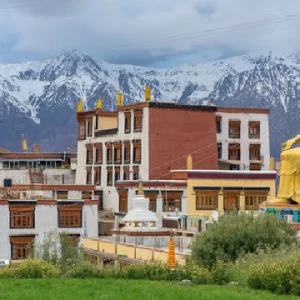
People Also Ask
What is Likir Monastery?
Likir Monastery, also known as Likir Gompa, is a Tibetan Buddhist monastery located in Ladakh, India. It belongs to the Gelugpa (Yellow Hat) sect of Tibetan Buddhism and was founded in the 11th century. The monastery is known for its stunning architecture, rich history, and its spiritual significance.
Where is Likir Monastery located?
Likir Monastery is located about 52 kilometers west of Leh, the capital of Ladakh. It sits atop a hill and offers breathtaking views of the surrounding mountains and valleys.
What is the history of Likir Monastery?
Likir Monastery was founded in the 11th century by Lama Duwang Chosje, with the support of King Lha-chen of Ladakh. It was originally built to preserve Tibetan Buddhist teachings and has played a vital role in spreading Buddhism throughout the region.
How can I reach Likir Monastery?
To reach Likir Monastery, you can drive from Leh, which takes about 1.5 to 2 hours. Alternatively, you can opt for a trek from nearby villages like Phyang, which provides a scenic route to the monastery.
What is the best time to visit Likir Monastery?
The best time to visit Likir Monastery is during the summer months, from May to September, when the weather is pleasant and the roads are accessible. The Tse-Chu festival, typically held in July or August, is also a great time to experience the monastery’s cultural rituals.
What can I expect to see at Likir Monastery?
At Likir Monastery, visitors can expect to see beautiful Tibetan Buddhist murals, statues of the Buddha, prayer wheels, stupas, and the 75-foot-high statue of Maitreya Buddha. The monastery also offers stunning views of the surrounding landscapes.
What is the significance of the Maitreya Buddha statue at Likir Monastery?
The Maitreya Buddha statue at Likir Monastery is a 75-foot tall representation of the future Buddha, symbolizing hope, peace, and enlightenment. It is one of the monastery’s most iconic features and is a symbol of the future transformation of the world.
What is the Tse-Chu festival at Likir Monastery?
The Tse-Chu festival is an important Buddhist festival celebrated at Likir Monastery. It honors Guru Padmasambhava and features vibrant prayer ceremonies, dances, and cultural performances. The festival usually takes place in July or August.
Are there any trekking opportunities around Likir Monastery?
Yes, there are several trekking opportunities around Likir Monastery. Popular treks include routes to Phyang Monastery and the Indus River, which provide scenic views of Ladakh’s rugged landscapes.
Can I stay at Likir Monastery?
Likir Monastery does not provide accommodations. However, there are various accommodation options available in Leh, ranging from budget guesthouses to luxury hotels. Visitors can also stay in nearby villages for a more immersive experience.
What is the best way to get to Leh from Likir Monastery?
To travel to Leh from Likir Monastery, you can hire a taxi or rent a bike. The drive takes around 1.5 to 2 hours and offers stunning views of the Indus Valley and surrounding landscapes.
Can I interact with the monks at Likir Monastery?
Yes, visitors are often allowed to interact with the monks at Likir Monastery, provided they do so respectfully. You can learn about Buddhist teachings, rituals, and practices directly from the monks.
Are there any local attractions near Likir Monastery?
Yes, nearby attractions include Alchi Monastery, Phyang Monastery, Magnetic Hill, Leh Palace, and the Indus River. You can also visit Nubra Valley for its unique sand dunes and monasteries.
Is photography allowed at Likir Monastery?
Yes, photography is generally allowed at Likir Monastery, but it is important to seek permission before taking photos of the monks or during prayer ceremonies, as they may prefer privacy during their spiritual practices.
How long should I spend at Likir Monastery?
A visit to Likir Monastery typically takes 1 to 2 hours, allowing enough time to explore the temple, admire the artwork, and enjoy the peaceful surroundings. If you are attending a festival, you may wish to spend more time to fully experience the cultural rituals.
What is the significance of prayer wheels at Likir Monastery?
The prayer wheels at Likir Monastery are sacred tools used by practitioners to spread positive energy. Spinning the wheels is believed to send out prayers for the well-being of all living beings, a core practice in Tibetan Buddhism.
Can I participate in meditation at Likir Monastery?
While you may not be able to formally participate in monk-led meditation sessions, you can certainly meditate on your own in the peaceful surroundings of the monastery. Many visitors take time to meditate near the Maitreya Buddha statue or in the monastery’s serene courtyards.
Is Likir Monastery open to tourists year-round?
Yes, Likir Monastery is open to tourists year-round. However, the best time to visit is during the summer months, from May to September, as the weather is more accessible and the monastery’s surrounding roads are open.
What should I wear when visiting Likir Monastery?
When visiting Likir Monastery, it is important to dress modestly and respectfully. Light, comfortable clothing is appropriate, but it is best to avoid wearing revealing attire. Keep in mind that this is a place of worship and spiritual reflection.
Are there any local restaurants near Likir Monastery?
While Likir Monastery does not have restaurants nearby, Leh, which is about 1.5 to 2 hours away, offers a variety of dining options ranging from traditional Ladakhi cuisine to international dishes. Some popular restaurants in Leh include The Tibetan Kitchen and Shanti Restaurant.
How long does it take to reach Likir Monastery from Leh?
The journey from Leh to Likir Monastery takes around 1.5 to 2 hours by car. The drive offers stunning views of the Indus Valley, and you can enjoy the unique landscape of Ladakh along the way.
Can I visit Likir Monastery during the winter?
It is possible to visit Likir Monastery during the winter, but the cold temperatures and snow may make it challenging to travel to Ladakh. Most roads are open from May to September, making this the ideal time for a visit.
What type of activities can I do at Likir Monastery?
At Likir Monastery, visitors can explore the temple, admire the intricate murals and statues, observe monks during their rituals, spin the prayer wheels, meditate, and take in the breathtaking views of Ladakh’s landscapes.
Is there a fee for visiting Likir Monastery?
While there is no formal entry fee for visiting Likir Monastery, visitors are encouraged to make a donation to support the monastery’s upkeep and the monks’ religious activities. Donations are voluntary and greatly appreciated.
Can I learn about Tibetan Buddhism at Likir Monastery?
Yes, Likir Monastery is an excellent place to learn about Tibetan Buddhism. The monks are often open to sharing information about their practices, teachings, and daily rituals. Visitors can also explore the murals and scriptures that provide insight into Buddhist philosophy.
Is there a dress code at Likir Monastery?
While there is no formal dress code at Likir Monastery, visitors are expected to dress modestly. It is recommended to wear respectful attire, covering shoulders and knees. Avoid wearing overly casual clothing like shorts and tank tops when entering the monastery complex.
What is the importance of Likir Monastery in Ladakh?
Likir Monastery is an important spiritual center in Ladakh. It has served as a hub for Buddhist teachings for centuries and continues to preserve Tibetan Buddhist traditions. The monastery is also a historical landmark and a cultural treasure for the region.
How can I contribute to Likir Monastery?
Visitors can contribute to Likir Monastery through donations, which help with its upkeep, preservation of religious relics, and supporting the monks’ daily activities. Donating towards the monastery’s charity programs or sponsoring prayer sessions are also meaningful ways to contribute.
Can I buy souvenirs at Likir Monastery?
Yes, visitors can purchase small souvenirs, such as prayer beads, Tibetan artifacts, and traditional handicrafts, at Likir Monastery. These items are often sold in small stalls near the entrance and make for meaningful keepsakes from your visit.
What makes Likir Monastery different from other monasteries in Ladakh?
Likir Monastery stands out for its combination of historical significance, beautiful architecture, and the presence of the towering Maitreya Buddha statue. Its remote and peaceful location, as well as its association with the Gelugpa tradition, makes it a unique destination in Ladakh.

